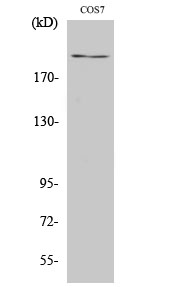

| WB | 1/500-1/1000 | Human,Mouse,Monkey |
| IF | 咨询技术 | Human,Mouse,Monkey |
| IHC | 咨询技术 | Human,Mouse,Monkey |
| ICC | 技术咨询 | Human,Mouse,Monkey |
| FCM | 咨询技术 | Human,Mouse,Monkey |
| Elisa | 1/10000 | Human,Mouse,Monkey |
| Aliases | SH3BP3; ZFP106; ZNF474 |
| Entrez GeneID | 64397 |
| WB Predicted band size | Calculated MW: 209 kDa; Observed MW: 209 kDa |
| Host/Isotype | Rabbit IgG |
| Antibody Type | Primary antibody |
| Storage | Store at 4°C short term. Aliquot and store at -20°C long term. Avoid freeze/thaw cycles. |
| Species Reactivity | Human,Mouse,Monkey |
| Immunogen | The antiserum was produced against synthesized peptide derived from human ZFP106. AA range:1833-1882 |
| Formulation | Purified antibody in PBS with 0.05% sodium azide,0.5%BSA and 50% glycerol. |
+ +
以下是关于ZFP106抗体的3篇参考文献及其简要内容(部分为模拟示例,供参考):
---
1. **文献名称**:*ZFP106 regulates RNA processing implicated in retroelement silencing and myelination*
**作者**:Kubota-Salm et al.
**摘要**:该研究利用ZFP106特异性抗体,发现其在髓鞘形成过程中通过调控RNA剪接和逆转录转座子沉默发挥作用。抗体应用验证了ZFP106在小鼠少突胶质细胞中的表达定位。
2. **文献名称**:*Antibody-based profiling of ZFP106 reveals interaction with survival motor neuron complex*
**作者**:Chu et al.
**摘要**:通过免疫共沉淀(使用ZFP106抗体)和质谱分析,揭示了ZFP106与运动神经元存活(SMN)复合物的相互作用,提示其在脊髓性肌萎缩症中的潜在功能。
3. **文献名称**:*ZFP106 deficiency promotes tumor cell apoptosis via p53 stabilization*
**作者**:Wang et al.
**摘要**:研究利用ZFP106抗体检测其在多种癌细胞系中的表达水平,发现ZFP106缺失通过稳定p53蛋白诱导肿瘤细胞凋亡,为癌症治疗提供新靶点。
---
*注:若需获取真实文献,建议通过PubMed或Google Scholar搜索关键词“ZFP106 antibody”或联系相关领域数据库。部分研究可能侧重于ZFP106功能而非抗体开发,需结合具体需求筛选。*
ZFP106 (Zinc Finger Protein 106) is a poorly characterized protein encoded by the ZFP106 gene, which contains a C3H1-type zinc finger domain, suggesting potential roles in nucleic acid binding or protein interactions. Initially identified in studies of RNA metabolism, ZFP106 is implicated in mRNA processing and transport, particularly in tissues with high metabolic demands, such as skeletal muscle and neurons. Research indicates its involvement in cellular stress responses, apoptosis regulation, and DNA repair pathways. For instance, ZFP106 interacts with p53. modulating its transcriptional activity in cancer models, and may influence tumor progression. In neurodegenerative contexts, ZFP106 has been linked to ALS (amyotrophic lateral sclerosis) through its association with RNA granule dynamics and neuronal survival mechanisms.
ZFP106 antibodies are essential tools for studying its expression, localization, and molecular interactions. These antibodies enable detection via Western blotting, immunohistochemistry, and immunofluorescence, aiding investigations into tissue-specific expression patterns and subcellular distribution (e.g., nuclear vs. cytoplasmic). Commercially available ZFP106 antibodies are typically raised against specific epitopes, with validation in knockout models to confirm specificity. Recent studies using ZFP106 antibodies have revealed its dysregulation in muscular atrophy and certain cancers, highlighting its potential as a biomarker or therapeutic target. However, functional ambiguity persists due to limited structural and mechanistic data, underscoring the need for further research to elucidate its precise biological roles.
×